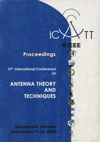Efficiency of wireless power transmission system with non-axial arrangement of transmitting and receiving apertures
DOI:
https://doi.org/10.1109/ICATT.2003.1238886Keywords:
WPT system efficiency, transmitting antenna, rectenna, apertures' non-axialityAbstract
A mathematical model of a wireless power transmission (WPT) system, taking into account the presence of an error in coaxiality of the transmitting antenna and rectenna is presented. Relations for the intercept efficiency were obtained for the case of the transmitting antenna circular aperture and rectenna square aperture. Methods for calculating the WPT system rectification and collection efficiency were developed. Numerical and experimental investigations into the impact of the error in coaxiality on the WPT system efficiency were performed.References
Shifirin, Y.S.; Shokalo, V.M.; Luchaninov, A.I.; Konovaltsev, A.A. The investigations in wireless energy transmission at the Kharkiv National University of Radio Electronics. Proc. of the XXVII General Assembly of the Int. Union of Radio Science, Netherlands, Maastricht, pp. 1353-1357.
Shokalo, V.M.; Rybalko, A.M.; et al. Power transmission with a microwave beam with non-coaxial arrangement of the transmitting and receiving apertures. Radiotekhnika (Kharkiv), 2000, No. 115.
Fradin, A.Z. Microwave antennas. M.: Sov. Radio, 1957, p. 69-80 [in Russian].
Shokalo, V.M.; et al. Simulation of large aperture rectennas for space energy systems. Model of large aperture rectenna for calculation of the rectification efficiency with a coaxial arrangement of the transmitting and receiving apertures and varying range of energy transmission. Radiotekhnika (Kharkiv), 2001, No. 121.
Luchaninov, A.I.; et al. Theoretical and experimental investigations of large aperture antenna arrays. Radiotekhnika (Kharkiv), 1998, No. 106, p. 63-72.
Shokalo, V.M. Analysis and design of the circuits for the rectenna direct current power collection. Part 1. Efficiency of the collection circuits with series and parallel connection of receiving-rectifying elements in the rcctenna direct current. Radiotekhnika (Kharkiv), 1993, No. 97, p. 67-73.
Luchaninov, A.I.; et al. Algorithm for analysis of an equidistant array of multistrip radiators of random geometry adapted to calculation of large aperture antennas with non-linear elements. 1. Model, geometry description and integral equations system for the currents of microstrip radiators of the complicated geometry being a part of the infinite array. Radiotekhnika (Kharkiv), 2001, No. 117, p. 78-84.
Luchaninov, A.I.; et al. Algorithm for analysis of an equidistant array of microstrip radiators of random geometry adapted to calculation of large aperture antennas with non-linear elements. 2. Solution of the integral equation system. Radiotekhnika (Kharkiv), 2001, No. 118, p. 3-7.
Luchaninov, A.I.; et al. Algorithm for analysis of an equidistant array of microstrip radiators of random geometry adapted to calculation of large aperture antennas with nonlinear elements. 3. Peculiarities of numerical implementation of the algorithm. Radiotekhnika (Kharkiv), 2001, No. 119, p. 199-210.
Luchaninov, A.I.; et al. Algorithm for analysis of an equidistant array of microstrip radiators of random geometry adapted to calculation of large aperture antennas with non-linear elements. 4. Test problems solution results. Radiotekhnika (Kharkiv), 2001, No. 120, p. 8-11.

